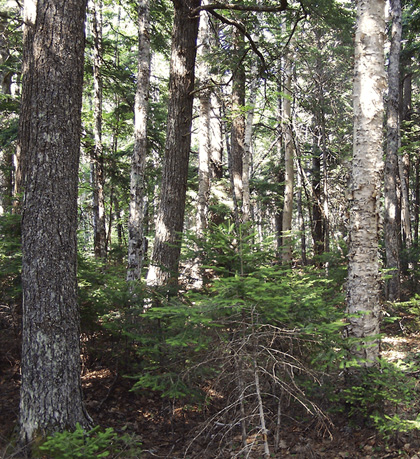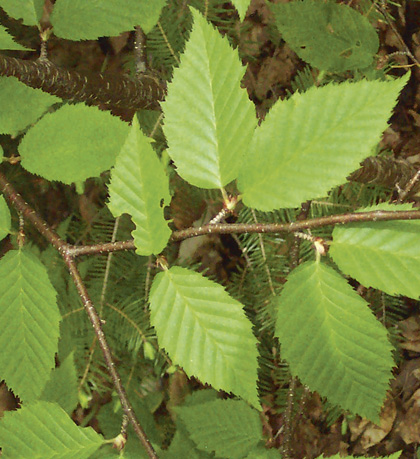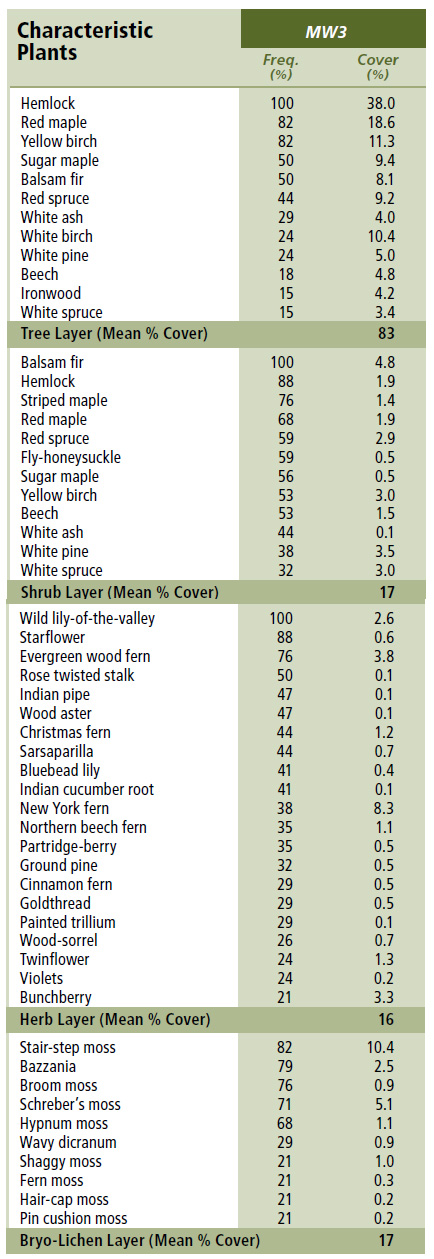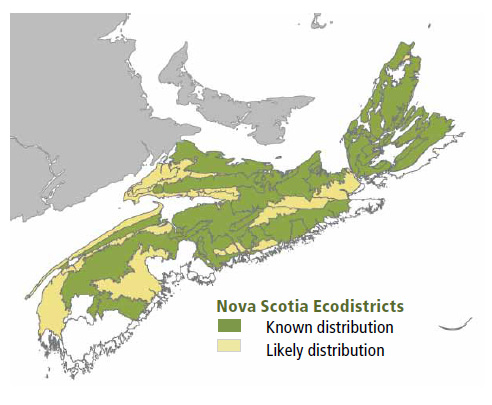
Forest Vegetation types - MW3
MW3 — Hemlock – Yellow birch / Evergreen wood fern
Tsuga canadensis – Betula alleghaniensis / Dryopteris intermedia
 |
Durham, Pictou County |
Concept: This late successional mixedwood Vegetation Type (VT) has an overstory co-dominated by hemlock and yellow birch. Various other trees, including many shade-tolerant species, may be lesser associates. This VT is similar to MW1 (Red spruce – Yellow birch / Evergreen wood fern), but has greater hemlock prominence. The longevity and shade tolerance of the dominant overstory tree species aids in the development of old forest characteristics, maintained by gap disturbances. Hemlock – Yellow birch / Evergreen wood fern is a climax Acadian mixedwood VT found on zonal sites.
Vegetation: Hemlock is the dominant overstory tree, co-occurring with yellow birch and/or red maple. A suite of other shade-tolerant trees (e.g. sugar maple, beech, balsam fir, white pine and white ash) may also be present to varying degrees. The shrub layer is moderately developed and includes mainly regenerating trees, striped maple and fly-honeysuckle. The herb layer is represented by typical mixedwood forest flora. Ferns, club-mosses, and various flowering perennials such as bluebead lily, wild lily-of-the-valley, starflower, Indian cucumber root, partridge-berry and wood aster are common. Poorer sites can support pink lady's slipper, teaberry and bracken, while richer sites are represented by Christmas fern, oak fern and northern beech fern. Sites with higher moisture may support cinnamon fern and creeping snowberry, while drier sites may contain increased hay-scented fern. Bryophyte development varies, with coverage directly related to relative softwood abundance in the overstory. Schreber's moss and stair-step moss are the main bryophyte species. Bazzania can also be common where coarse woody debris has accumulated on the forest floor.
Environmental Setting: MW3 is mainly associated with fresh to fresh-moist, nutrient medium to rich soils of variable texture. Coarse woody debris coverage can be quite variable on MW3 sites due to the short lifespan of balsam fir which is always a significant component of this VT. This VT can be found throughout mainland Nova Scotia, with scattered occurrences in Cape Breton. This ecosystem occurs on Prince Edward Island and in parts of southern and central New Brunswick, but it is relatively rare in both jurisdictions.
Successional Dynamics: MW3 is a late successional climatic climax VT co-dominated by hemlock with lesser yellow birch and/or red maple. It can develop from several early and mid-successional VTs including SH5 (Red spruce – Balsam fir /Schreber's moss), SH6 (Red spruce – Balsam fir / Stair-step moss – Sphagnum), SH8 (Balsam fir / Wood fern / Schreber's moss) and MW4 (Balsam fir – Red maple / Wood sorrel – Goldthread). Early successional stages can be by-passed if, at the time of disturbance, advanced hemlock regeneration is present and retained. Depending on disturbance history this VT can be even-aged, but it will develop an uneven-aged structure as it matures. Between large-scale disturbance events this VT will maintain itself through gap replacement.
Ecological Features: This closed canopy forest is matrix-forming in central Nova Scotia and a large patch forest elsewhere. The shade tolerance and longevity of hemlock and yellow birch promote development of uneven-aged canopy structure and old growth. Large trees can provide nest sites for pileated woodpeckers, red-tailed hawks and northern goshawks. Downed coarse woody debris may provide cover for red-backed salamanders and small mammals. Mixedwood forests can also provide both shelter and food for overwintering deer. Yellow birch is an abundant source of seed during the winter for many species of birds and small mammals. Birch trees in these forests may be deformed and killed by birch cinder conch, a fungal growth occasionally harvested for Chaga tea.
 |
| Yellow birch |
Distinguishing Features: This mixedwood forest occurs on well drained soils dominated by yellow birch and hemlock with a significant component of red maple. Striped maple and fly-honeysuckle along with ferns are very common in the well-developed shrub and herb layers.
| Slope Position: | Level3 Lower3 Middle2 Upper2 |
Surface Stoniness: |
(Non - Slightly)8 (Moderately)2 |
Bedrock Outcrop: |
(Non-rocky)9 (Slightly - Moderately)1 |
Elevation Range: |
15 - 152m |
Slope Gradient: |
Gentle4 Level3 Steep1 Other1 nd1 |
Aspect: |
North3 East2 South2 West1 None2 |
Exposure: |
Moderate6 Sheltered2 Mod. exposed1 Mod. sheltered1 |
Microtopography: |
Moderately4 Slightly4 Strongly2 |
Drainage: |
Moderately well4 Imperfect3 Well3 |
Soil Type: |
ST22 ST62 ST11 ST2-L1 ST3-L1 ST81 ST121 Other1 |
Parent Material: |
Glacial till7 Alluvium1 Colluvium1 Glaciofluvial1 |
Rooting Depth (cm): |
(<30)1 (30-45)4 (>45)4 nd1 |
Duff Thickness (cm): |
(0-5)2 (6-10)5 (11-20)2 nd1 |

